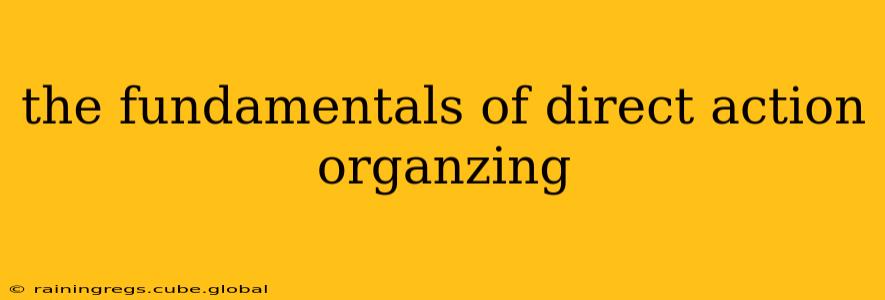Direct action organizing is a powerful tool for social and political change, focusing on immediate, visible actions to challenge power structures and achieve specific goals. Unlike traditional lobbying or electoral politics, it emphasizes direct confrontation and disruption to raise awareness and force concessions. Understanding its fundamentals is crucial for anyone interested in creating impactful social change. This guide delves into the core principles and strategies, answering many frequently asked questions about this impactful approach.
What is Direct Action?
Direct action is a form of political participation that involves taking direct action to bring about change. It's about bypassing traditional political channels and engaging in activities that directly challenge the status quo. This might involve protests, civil disobedience, boycotts, strikes, occupations, and other forms of non-violent or sometimes violent confrontation. The key is that the action is aimed at producing immediate change, not simply influencing opinion.
What are the different types of direct action?
Direct action encompasses a wide range of tactics, each with its own strengths and weaknesses. Some common examples include:
- Protests and Marches: Large-scale demonstrations designed to raise public awareness and apply pressure on authorities.
- Civil Disobedience: Deliberately breaking laws deemed unjust to highlight injustice and challenge the legitimacy of the state. This often involves accepting arrest as a consequence.
- Boycotts: Refusing to buy or use goods or services from a company or organization to pressure them to change their policies.
- Strikes: Workers refusing to work to pressure employers to meet their demands.
- Occupations: Taking control of a building or space to disrupt normal operations and raise awareness.
- Non-violent resistance: This umbrella term covers many tactics, emphasizing non-violent means to achieve objectives.
What are the goals of direct action organizing?
The goals of direct action are varied and depend on the specific context, but generally, they aim to:
- Raise Awareness: Bring public attention to an issue and build support for a cause.
- Apply Pressure: Force authorities or organizations to change their policies or behavior.
- Achieve Concrete Gains: Secure specific concessions or improvements for a community or group.
- Challenge Power Structures: Expose and confront systems of oppression and inequality.
- Build Solidarity: Foster a sense of community and collective action among participants.
How do you plan and execute a direct action campaign?
Successful direct action requires careful planning and execution. Key steps include:
- Issue Selection: Identifying a clear, well-defined issue that warrants direct action.
- Goal Setting: Defining specific, measurable, achievable, relevant, and time-bound (SMART) goals.
- Strategy Development: Choosing appropriate tactics and developing a comprehensive plan.
- Recruitment and Training: Building a strong team of committed activists and providing necessary training.
- Risk Assessment and Mitigation: Identifying potential risks and developing strategies to minimize harm.
- Media Strategy: Developing a plan to attract media attention and disseminate the message.
- Post-Action Analysis: Evaluating the effectiveness of the action and learning from successes and failures.
What are the ethical considerations of direct action?
Direct action, even when non-violent, raises ethical questions. Key considerations include:
- Proportionality: Ensuring the actions are proportionate to the harm caused by the issue being addressed.
- Non-violence: Committing to non-violent tactics, even in the face of provocation.
- Inclusivity: Ensuring the campaign is inclusive and respects the diverse perspectives of all participants.
- Accountability: Establishing mechanisms for accountability and addressing potential negative consequences.
What are some examples of successful direct action campaigns?
History is filled with examples of successful direct action campaigns, including the Civil Rights Movement in the United States, the anti-apartheid movement in South Africa, and numerous environmental justice movements around the world. These campaigns demonstrate the power of sustained, organized direct action to achieve significant social change.
What are the potential risks and challenges of direct action?
While direct action can be incredibly effective, it also carries risks. These can include:
- Arrest and Prosecution: Participants may face arrest and legal consequences.
- Violence and Injury: The potential for violence from authorities or counter-protestors.
- Repression: Governments may respond with increased repression and surveillance.
- Internal Conflicts: Disagreements among participants can hinder effectiveness.
- Backlash: Public opinion may turn against the movement.
Direct action organizing demands commitment, careful planning, and a deep understanding of the issues at stake. By acknowledging the potential risks and engaging in thorough preparation, activists can significantly increase their chances of success in creating lasting social change. The careful consideration of ethical implications and community needs is paramount to the success and integrity of any direct action campaign.
